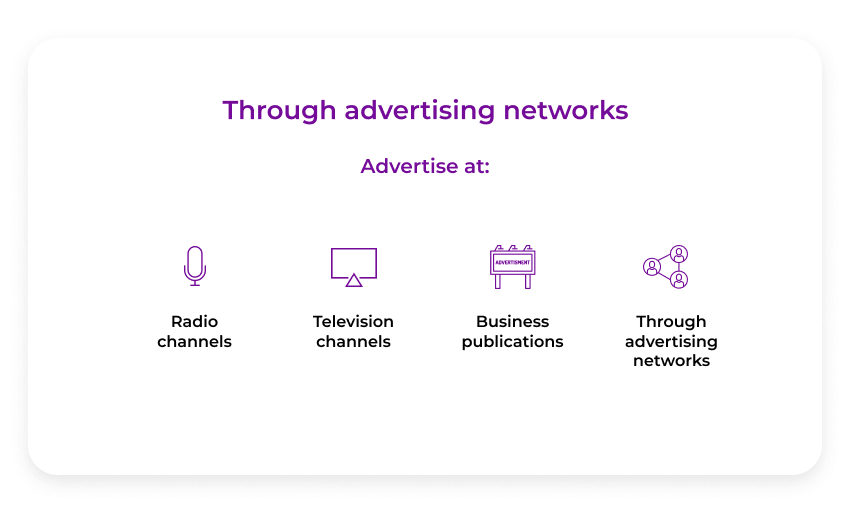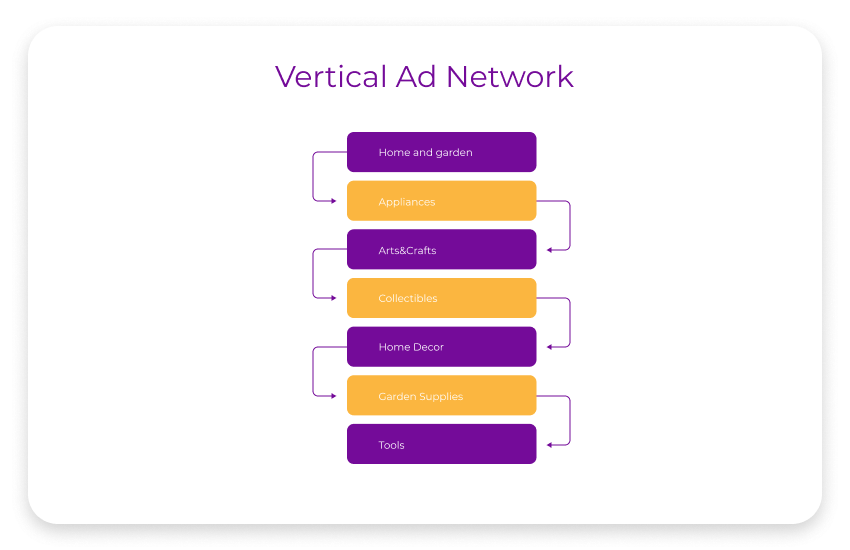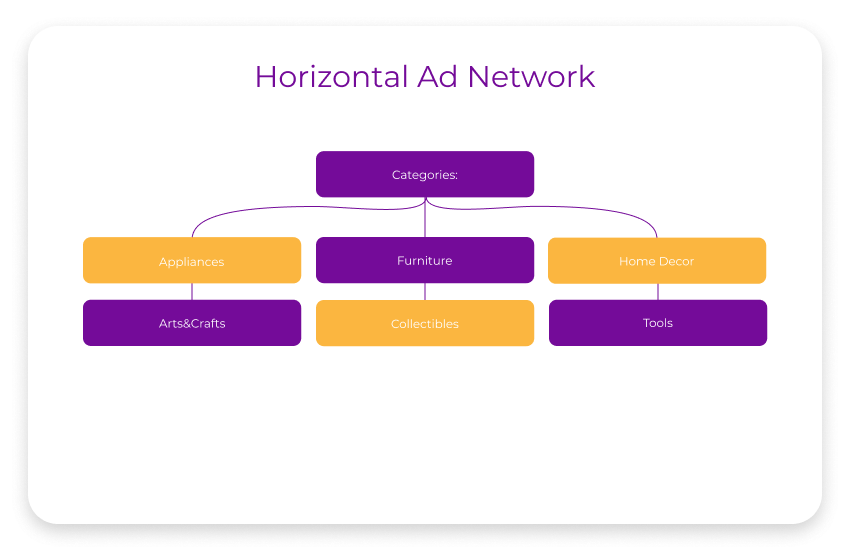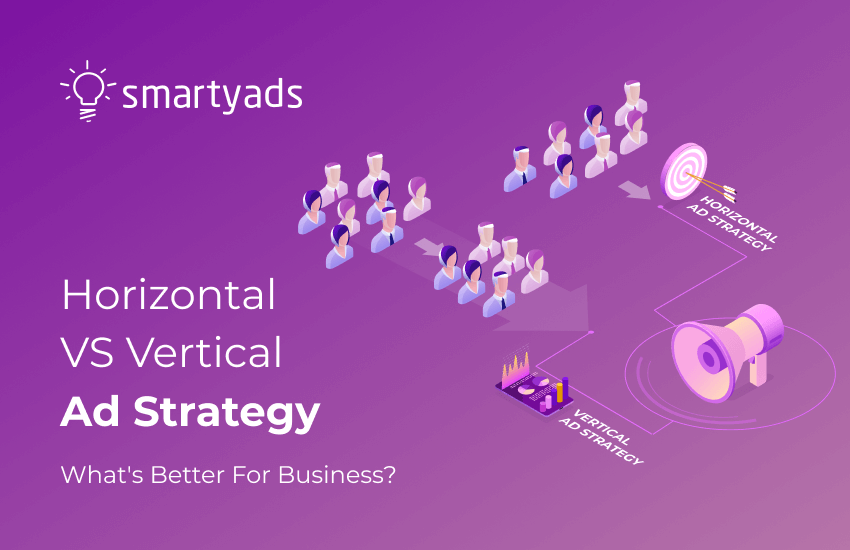Which advertising strategy is best: vertical or horizontal? It is the most common question that business owners ask themselves when the market competition gets tough.
Aptly chosen advertising strategy can be an excellent tool for effective budget management. Most importantly, it helps to focus the company’s efforts in certain areas where the likelihood of success will be much higher. Even though profit is the ultimate purpose of every business functioning, there is no such thing as a single advertising strategy that would equally suit all businesses.
So, what are horizontal and vertical advertising types? What do they have to do with vertical and horizontal ad networks? Finally, how to find out if horizontal or vertical ad strategy will work out for your business? Let's review how to create a robust full funnel marketing strategy and how to make the right choice!

What is vertical advertising?
Vertical advertising is a strategy that companies apply to target customers within a specific industry. A good example is publishing, insurance, real estate, transport, health care, etc.
People within any given vertical have relatively similar interests, needs, and demands; therefore, the customer base is also relatively homogeneous. Rather than appealing to broad groups of consumers, vertical advertising addresses the needs of a distinct niche.
When to apply vertical advertising?
Vertical ad strategy makes sense if your business offers very specific products or services. Advertising to the broader demographics beyond the niche will elicit weak response/conversions and more money per user acquisition. Thus, it will make no sense.
Who and why should use vertical advertising?
A vertical marketing strategy can be applied by the companies that want to target the most significant market sectors of their products or services. Companies with narrow specialization have lower levels of competition, but they also have higher risks of fluctuating demand, which makes customer relations incredibly important.
Building an effective vertical ad strategy
Because the audience for the product is narrowly defined, marketers are able to prepare highly targeted vertical advertising and promotional campaigns dedicated to their unique audience. Although the reach of the advertising might be limited, it is exact and precise, so every connection is crucial.
The general advice is to advertise via online and offline industry-specific channels. For example, a business specialized in food should focus on advertising through a food-specific vertical ad network and publications, take part in trade events and workshops about food, and include specific keywords into their content. DSP is another convenient tool for vertical advertising, as it allows targeting by chosen business verticals. Performing a vertical ad strategy often requires vast knowledge so choosing an expert is usually a key.

Example of successful vertical advertising
Lefty’s San Francisco sells a variety of products, including school and office supplies, kitchen utensils, gardening tools, and accessories — all specifically designed for left-handers.
Realizing that only 10 percent of the population is left-handed, Lefty’s capitalized on a natural niche market. Lefty’s advertises to its target audience with pay-per-click marketing: If a person is searching for left-handed scissors on Google, the Lefty’s online store will be the first website on the list.
What is horizontal advertising?
Horizontal advertising is a strategy that implies appealing to potential customers who share some common characteristics but are distributed across a range of industries.
To put it simply, in horizontal advertising companies find audiences with similar needs, interests, and requirements among general, non-industry classified pools.

When to apply horizontal advertising?
Compared to vertical advertising, horizontal advertising is more diverse because it appeals to a broader clientele. This requires marketers to design more sophisticated cross-channel campaigns using various marketing tactics.
Who and why should use horizontal advertising?
Companies that offer a standard product or service can use horizontal advertising in order to appeal to a wide range of customers. For instance, an office paper brand might create an advertising campaign that targets banks, offices, bureaus, agencies, public administration offices, and other organizations. Such products enjoy wide applicability and high demand, so the competition within the horizontal markets is high.
Because the companies cater to large audiences, the customers’ bargaining power is minimized, and the businesses have more price control than in vertical markets where fluctuations are common.
Horizontal advertising also appeals to broad channels oriented on the general public, such as radio channels, television, and general business publication. It is also a common practice to use advertising networks for horizontal ads.
Building an effective horizontal ads strategy
Horizontal customer interaction may require vendors to focus on different aspects of product marketing. For example, a bakery might advertise its products to families pointing as low-carb and gluten-free, while presenting the same product to luxury magazines with gourmet characteristics.

Example of successful horizontal advertising
Some companies choose to collaborate to reach broader and diverse audiences and get the most of their marketing opportunities. For example, Coca-Cola allied with Pringles, and the two items were marketed and distributed together. This allowed both businesses to increase production capabilities and maximize revenues dramatically.
By offering standardized products, the companies can operate at a larger scale, which ensures the lower production cost. Moreover, the production of standardized products is easily automated, which results in additional cost savings.
Horizontal vs vertical marketing: how to choose?
Vertical ad networks specialize in gathering traffic for specific audience segments. This way their reach is more humble than in horizontal networks. Nevertheless, it will be just enough to use a vertical advertising network in order to satisfy the needs of the narrow-niche brand.

Vertical ad networks are effective at delivering industry-specific traffic and ensuring transparency to the advertiser. However, if you apply strategies for vertical advertising it doesn’t necessarily mean you are bound to use vertical ad networks.
Horizontal ad networks offer global, large-scale, and numerous targeting capabilities for marketers. Horizontal networks accumulate inventory from hundreds of thousands of web sources, including verticals of all types.

So, although initially, they don’t target certain industries, they feature broader targeting options advertisers can define themselves. Thus, SmartyAds horizontal ad network offers targeted experience according to 30+ options including geolocation, OS, IP, gadget, traffic type, etc. This way, you can advertise on selected content channels and show the ads only to the users who are most likely to convert.
| Vertical advertising | Horizontal advertising |
| Specialized | Non-specialized |
| Focused on a specific target audience (searching by verticals) | Oriented at the general and narrow audiences (singled out with targeting options) |
| Exact and effective reach | Wider reach |
| Advertising via industry-specific channels, vertical ad network | Advertising via TV, radio, printed publications, horizontal ad networks |
The good news is - not necessarily you have to choose between horizontal vs vertical marketing. Being an expert in one narrow field allows you to market yourself using vertical advertising networks, but you can also offer your services to organizations within related niches by building a horizontal advertising strategy.
The takeaway
Both vertical and horizontal advertising approaches have their own advantages and specifics. If you define the right purpose, target the right audience, and serve your message in the right context, campaigns will bring good ROI and significant user engagement.
The combination of proficient bid management with narrow targeting is a core feature of SmartyAds ad exchange that will help you drive campaign results at each stage of the marketing funnel.
Make the most out of horizontal and vertical advertising on SmartyAds DSP!





